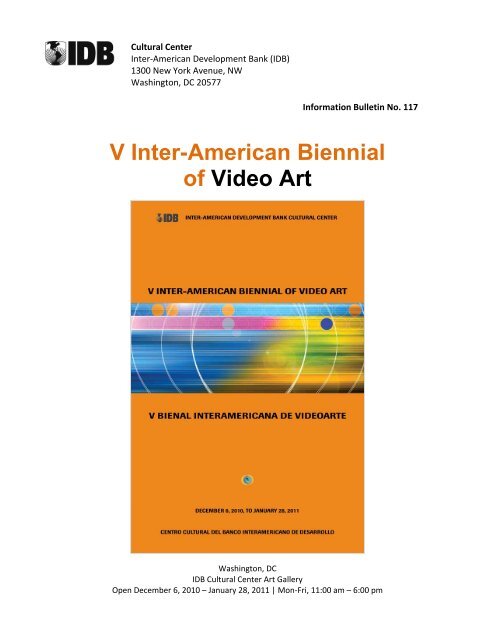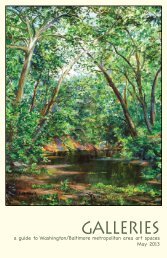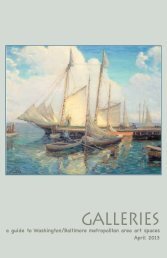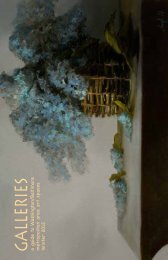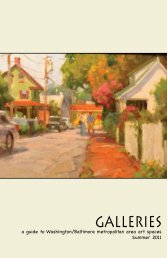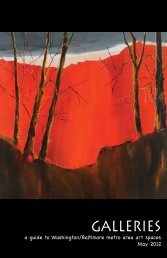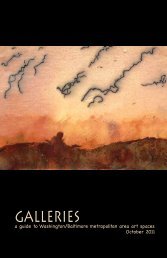V Inter-American Biennial of Video Art - Galleries Magazine
V Inter-American Biennial of Video Art - Galleries Magazine
V Inter-American Biennial of Video Art - Galleries Magazine
Create successful ePaper yourself
Turn your PDF publications into a flip-book with our unique Google optimized e-Paper software.
Cultural Center<br />
<strong>Inter</strong>‐<strong>American</strong> Development Bank (IDB)<br />
1300 New York Avenue, NW<br />
Washington, DC 20577<br />
Information Bulletin No. 117<br />
V <strong>Inter</strong>-<strong>American</strong> <strong>Biennial</strong><br />
<strong>of</strong> <strong>Video</strong> <strong>Art</strong><br />
Washington, DC<br />
IDB Cultural Center <strong>Art</strong> Gallery<br />
Open December 6, 2010 – January 28, 2011 | Mon‐Fri, 11:00 am – 6:00 pm
The Cultural Center<br />
<strong>of</strong> the <strong>Inter</strong>‐<strong>American</strong> Development Bank (IDB)<br />
announces the opening <strong>of</strong> the exhibition<br />
V <strong>Inter</strong>-<strong>American</strong> <strong>Biennial</strong><br />
<strong>of</strong> <strong>Video</strong> <strong>Art</strong><br />
Open December 6, 2010 – January 28, 2011<br />
20 videos from 13 countries were selected from among 223 entries<br />
by an international jury composed <strong>of</strong><br />
Marina Galvani, Curator <strong>of</strong> the <strong>Art</strong> Program <strong>of</strong> the World Bank, and<br />
Edgar Endress, Assistant Pr<strong>of</strong>essor <strong>of</strong> Digital Media Technologies at George Mason University.<br />
_____________________________________________________________________________________<br />
Washington, December 3, 2011<br />
The Fifth Edition <strong>of</strong> the <strong>Inter</strong>‐<strong>American</strong> <strong>Biennial</strong> <strong>of</strong> <strong>Video</strong> <strong>Art</strong> will open at the Gallery <strong>of</strong> the IDB Cultural Center, in<br />
Washington, featuring 20 videos from 13 countries selected from among 223 entries from 20 countries, including<br />
Puerto Rico. This year, the <strong>Biennial</strong> celebrates its first decade <strong>of</strong> existence.<br />
In the words <strong>of</strong> the IDB Cultural Center Director and creator <strong>of</strong> the <strong>Biennial</strong>, Felix Angel, “The <strong>Inter</strong>‐<strong>American</strong><br />
<strong>Biennial</strong> <strong>of</strong> <strong>Video</strong> <strong>Art</strong> is probably the only video biennial that exists at the hemispheric level and operates under an<br />
open call instead <strong>of</strong> through preselected entries under a rigid curatorial framework. This is an important<br />
distinction that has become part <strong>of</strong> the <strong>Biennial</strong>’s character. Aside from the cash awards and honorable mentions<br />
awarded by an international jury to encourage those artists whose work appears most innovative and progressive,<br />
the <strong>Biennial</strong>´s openness and inclusivity gives opportunities to many video artists in the region to be appreciated by<br />
a wide range <strong>of</strong> publics.”<br />
The winning entries and their video artists <strong>of</strong> this year edition are:<br />
• First Prize <strong>of</strong> US$4,000 to the video “Faber,” by Boris David Franco Navarrete, <strong>of</strong> Chile. From beginning to end,<br />
this work develops with the majesty and unity <strong>of</strong> a symphony in which images and sound dialogue in perfect<br />
rhythmic alternation. The theme, rooted in global philosophical and religious traditions, is treated with elegance<br />
and beauty.<br />
2
• Second Prize <strong>of</strong> US$3,000 to the video “Between My Hands,” by Alexandre Braga Brandão, <strong>of</strong> Brazil. Exactly as if<br />
interrogating a tarot card reader, the viewer <strong>of</strong> “Between My Hands” is <strong>of</strong>fered many reading keys: from an<br />
elaborated obsession reminiscent <strong>of</strong> contemporary times, to the casualness <strong>of</strong> outcomes in confrontations, to the<br />
anxiety <strong>of</strong> a growing technological world, all “packaged” in a rich, compelling and fresh visual game. The video is<br />
in a constant state <strong>of</strong> evolution and change. It shows a journey from the playful to the violent, passing through the<br />
distortion <strong>of</strong> technology, the symbolism <strong>of</strong> material culture, and its impact in our society.<br />
• Third Prize <strong>of</strong> US$2,000 to the video “Vigilantes (Museum Guards),” by Benjamín López Alcántara, <strong>of</strong> Mexico.<br />
This is either a pointed criticism <strong>of</strong> the indifference <strong>of</strong> security personnel in museums, or a disillusioned reflection<br />
on the appeal <strong>of</strong> contemporary art in (Latin <strong>American</strong>) society. Are they sad guardians <strong>of</strong> abandoned empty ships,<br />
or are the artworks on display no more than imperfections in the drywall With a terse and sophisticated<br />
language, “Vigilantes” cries, “The king is naked!” defying any taboo <strong>of</strong> solidarity in the “intellectual” world while<br />
showing the pathetic humanity <strong>of</strong> art’s guardians.<br />
• Honorable Mention <strong>of</strong> US$1,000 to the video “Aún aquí (Still Here),” by Paulina Alicia del Paso Gordillo, <strong>of</strong><br />
Mexico. Impeccable and elegant, “Aún aquí” collects, with full hands and clear awareness, visual and literary<br />
memorabilia, adding layer after layer <strong>of</strong> reference to the eternal discourse <strong>of</strong> “staying,” no matter what. It<br />
explores the magical and apocalyptic relations we experience in Latin <strong>American</strong> urban spaces.<br />
• Honorable Mention <strong>of</strong> US$1,000 to the video “Se me pergunto, por quê meus lábios negam respostas (I Ask<br />
Myself, Why Do My Lips Refuse to Answer)” by Joacélio Batista de Sousa Da Silva, <strong>of</strong> Brazil. “I Ask Myself, Why Do<br />
My Lips Refuse to Answer” walks a fine line between whimsical and grotesque. Trapped in the vertigo <strong>of</strong> a<br />
nightmare and the elation <strong>of</strong> a waltz, the possibility <strong>of</strong> escape through a verbal relationship with another human<br />
being is denied in a crescendo <strong>of</strong> claustrophobia.<br />
The entire list <strong>of</strong> selected videos, including those receiving awards and honorable mentions is as follows, in<br />
alphabetical order by country:<br />
Argentina<br />
1.<br />
El Capital, 2009<br />
(Das Kapital/The Capital)<br />
Marcello Rubén Mercado Romano<br />
Brazil<br />
2.<br />
Se me pergunto, por quê meus lábios negam<br />
respostas, 2010<br />
(I Ask Myself, Why Do My Lips Refuse to Answer)<br />
Joacélio Batista Da Silva de Sousa<br />
3.<br />
So Far Away . . . So Close, 2010<br />
(Tan lejos . . . Tan cerca)<br />
Tina Velho (Teresa Cristina Balthazar Pacheco Velho)<br />
4.<br />
Between My Hands, 2010<br />
(Entre mis manos)<br />
Alexandre Braga Brandão<br />
Chile<br />
5.<br />
Faber, 2009<br />
Boris David Franco Navarrete (Siro)<br />
6.<br />
Instrucciones de uso, 2009<br />
(Instructions for Use)<br />
José Antonio Pedreros Prado<br />
7.<br />
Aia, 2009<br />
Valentina Serrati Sisa<br />
Colombia<br />
8.<br />
Country Trademark (National Brand), 2009<br />
(Marca Nacional Registrada)<br />
Andrés Felipe Uribe Cárdenas<br />
9.<br />
Movimiento 0.1, Imaginación 2.5, 2010<br />
(Movement 0.1, Imagination 2.5)<br />
Raquel Solórzano Cataño<br />
10.<br />
Comienza un buen día, 2010<br />
3
(A Good Day Begins)<br />
Samanta Andrea Duque Posada<br />
Dominican Republic<br />
11.<br />
Inmutando, 2010<br />
(Mutating)<br />
Citlally Miranda Pérez<br />
Ecuador<br />
12.<br />
Qué tan lejos está el triunfo de la voluntad, 2009<br />
(How Far Away Is the Triumph <strong>of</strong> the Will)<br />
Ilich Bladimir Castillo Vera<br />
Guatemala<br />
13.<br />
Natural‐<strong>Inter</strong>venciones plásticas, 2009<br />
(Natural ‐ Plastic <strong>Inter</strong>ventions)<br />
Rodolfo Miguel Walsh Baeza<br />
Mexico<br />
14.<br />
Número uno, 2010<br />
(Number One)<br />
Francisco Javier Ventura Reyes<br />
15.<br />
Vigilantes, 2010<br />
(Museum Guards)<br />
Benjamín López Alcántara<br />
16.<br />
Aún aquí, 2010<br />
(Still Here)<br />
Paulina Alicia del Paso Gordillo<br />
Peru<br />
17.<br />
La espera, 2010<br />
(The Wait)<br />
Julio César Martínez Malqui<br />
Puerto Rico<br />
18.<br />
Generating a Paradise, 2010<br />
(Iluminando un paraíso)<br />
Carlos M. Ruiz‐Valarino Rodríguez<br />
19.<br />
Our Last Hero, 2010<br />
(Nuestro último héroe)<br />
Carlos M. Ruiz‐Valarino Rodríguez<br />
Venezuela<br />
20.<br />
Primera lección de vuelo – Aeropuerto Tempelh<strong>of</strong>,<br />
Berlin, 2010<br />
(First Flying Lesson – Tempelh<strong>of</strong> Airport, Berlin)<br />
Marco Antonio Montiel Soto<br />
About the Jurors<br />
Marina Galvani. After graduating in art history and economics from universities in<br />
Venice, Milan, Vienna, and the United States, and having worked as an expert in<br />
management <strong>of</strong> cultural heritage for international organizations (the European Union,<br />
the United Nations Educational, Scientific and Cultural Organization, the World Bank) as<br />
well as for museums on both sides <strong>of</strong> the ocean as an assistant curator and researcher<br />
(Kunsthistorisches Museum, Vienna; Museo del Prado, Madrid; Musée du Louvre, Paris;<br />
National Gallery <strong>of</strong> <strong>Art</strong>, Washington, D.C.), Marina Galvani finally found a home for her<br />
“schizophrenic” nature in the position <strong>of</strong> art curator for the World Bank Collection and<br />
head <strong>of</strong> the Bank’s <strong>Art</strong> Program. Her declared mission as head <strong>of</strong> that program is to<br />
support an international dialogue on crucial development themes via art. With this is<br />
mind, she sees the <strong>Art</strong> Program as a platform through which emerging artists can <strong>of</strong>fer<br />
acute social commentary on an international stage. A bit <strong>of</strong> a “treasure‐hunter”<br />
scouting for artists around the globe and a determined visionary, Galvani has<br />
conceived, organized, and curated more than seventy exhibitions promoting emerging artists from over one<br />
hundred countries since January 2005. She is based in Washington, DC, and has a delightful two‐year‐old<br />
daughter.<br />
4
Edgar Endress was born in Osorno, Chile, in 1970. Though he started out studying<br />
economics, in 1994, he shifted his emphasis, taking up the study <strong>of</strong> the audiovisual at<br />
the Institute <strong>of</strong> the <strong>Art</strong> <strong>of</strong> Communication (ARCOS) in Santiago, Chile, from which he<br />
graduated with the equivalent <strong>of</strong> a bachelor <strong>of</strong> fine arts degree in 1998. In 1999 he was<br />
awarded a fellowship from Syracuse University to pursue a master <strong>of</strong> fine arts degree<br />
with a concentration in art video, which he completed in 2001.<br />
Currently he is an Assistant Pr<strong>of</strong>essor in the Department <strong>of</strong> <strong>Art</strong> and Visual Technology<br />
at George Mason University, specializing in media arts. He has received numerous<br />
awards at video festivals, including Second Prize Fair: Play 2006 <strong>Video</strong> Festival, PLAY<br />
platform for Film & <strong>Video</strong>, Berlin Germany (2006); Third Prize in the Experimental<br />
Category for “Elvis Hates America” at the Athens Film and <strong>Video</strong> Festival in Athens,<br />
Ohio (2001); Best Student <strong>Video</strong>, at the 26th Annual New England Film & <strong>Video</strong><br />
Festival, NEFVF (2001); the Jury Award for “Anonymous” at the Third <strong>Biennial</strong> <strong>of</strong> <strong>Video</strong> and Electronic <strong>Art</strong> in<br />
Santiago, Chile (1999); Second Prize in the Experimental Category for “Anonymous” at Next Frame in Philadelphia<br />
(1999); First Prize in the Documentary <strong>Video</strong> category for “Wanglen or the New Fertility” at the Second <strong>Biennial</strong> <strong>of</strong><br />
<strong>Video</strong> and Electronic <strong>Art</strong> in Santiago, Chile (1997); and the Prize in Originality and Creativity for “Transutero” at<br />
the <strong>Inter</strong>national Festival <strong>of</strong> Film and <strong>Video</strong> in Valdivia, Chile (1996). He also received, in a national competition,<br />
the Grand Marnier Foundation Film Fellowship for the best graduate student video <strong>of</strong> 2001.<br />
His work has been shown in a variety <strong>of</strong> venues and exhibitions since 1997, including the Museum <strong>of</strong> Modern <strong>Art</strong><br />
in Buenos Aires, Argentina; the Museum <strong>of</strong> Modern <strong>Art</strong> <strong>of</strong> Cartagena, Colombia; the annual New England Film and<br />
<strong>Video</strong> Festival at the Boston Fine <strong>Art</strong>s Museum; the 20th World Wide <strong>Video</strong> Festival in Amsterdam; the ifa (Institut<br />
für Auslandsbeziehungen) Gallery group show “Nueva Vista” in Bonn, Stuttgart, and Berlin; the New York <strong>Video</strong><br />
Festival at Lincoln Center in New York; the One World <strong>Inter</strong>national Human Rights Documentary Film Festival in<br />
Prague; the Kassel Documentary Film and <strong>Video</strong> Festival in Kassel, Germany; the LA Freewaves Media Festival in<br />
Los Angeles; the 14th <strong>Video</strong>brasil <strong>Inter</strong>national Electronic <strong>Art</strong> Festival in São Paulo; the 14th Annual Dallas <strong>Video</strong><br />
Festival; the Museo Nacional Centro de <strong>Art</strong>e Reina S<strong>of</strong>ía in Madrid; the California Museum <strong>of</strong> Photography at the<br />
University <strong>of</strong> California Riverside; and the Museum <strong>of</strong> Latin <strong>American</strong> <strong>Art</strong> <strong>of</strong> Buenos Aires (MALBA).<br />
<strong>Video</strong> Circuit<br />
After the presentation in Washington, the winning and selected videos will travel to more than 25 venues in 15<br />
countries <strong>of</strong> Latin America, the Caribbean, Europe and the United States including:<br />
Argentina<br />
1. Centro Feca, Foro y Estudios Culturales<br />
Argentinos, Buenos Aires, Argentina<br />
2. CHATEAU CAC, Centro de <strong>Art</strong>e Contemporáneo,<br />
Córdoba, Argentina<br />
Brazil<br />
3. Associação Cultural <strong>Video</strong>brasil, São Paulo, Brazil<br />
4. Galeria de <strong>Art</strong>e KUNST, Rio de Janeiro, Brazil<br />
Colombia<br />
5. Corporación <strong>Inter</strong>nacional de Cine, Bogotá,<br />
Colombia<br />
6. Encuentro Nacional de Críticos y Periodistas del<br />
Cine, Pereira, Colombia<br />
7. Fundación Cine a la Calle, Cinemateca del Caribe,<br />
Barranquilla, Colombia<br />
5<br />
8. Fundación Urban<strong>Art</strong>e, Cali, Colombia<br />
9. Institución Universitaria de Bellas <strong>Art</strong>es y Ciencias<br />
de Bolívar, Colombia<br />
10. Latitud Comunicaciones, Medellín, Colombia<br />
11. Museum <strong>of</strong> Modern <strong>Art</strong>, Cartagena, Colombia<br />
12. Museo de <strong>Art</strong>e Moderno La Tertulia, Cali,<br />
Colombia<br />
Costa Rica<br />
13. Fundación Museos del Banco Central de San<br />
José, Costa Rica<br />
Chile<br />
14. Centro Cultural Palacio La Moneda, Santiago de<br />
Chile, Chile<br />
Dominican Republic
15. Centro Cultural Eduardo León Jimenes, Santiago<br />
de los Caballeros, Dominican Republic<br />
Ecuador<br />
16. ALTEREGO. Grupo de <strong>Art</strong>es Escénicas Visuales,<br />
Quito, Ecuador<br />
17. Fundación Octaedro, Quito, Ecuador<br />
18. Río Revuelto, Guayaquil, Ecuador<br />
Honduras<br />
19. Centro de <strong>Art</strong>es Visuales Contemporáneo de<br />
Mujeres en las <strong>Art</strong>es y Asociación de Mujeres en las<br />
<strong>Art</strong>es “Leticia de Oyuela”, CAVC/ MUA, Tegucigalpa,<br />
Honduras<br />
Italy<br />
20. Istituto Italo‐Latino <strong>American</strong>o (IILA), Roma, Italy<br />
Nicaragua<br />
21.<br />
Bienal de <strong>Art</strong>es Visuales del Istmo Centroamericano,<br />
Managua, Nicaragua<br />
Panama<br />
22. Museum <strong>of</strong> Contemporary <strong>Art</strong>, Panama City,<br />
Panama<br />
Peru<br />
23. Alta Tecnología Andina, ATA Cultural, Lima, Peru<br />
Spain<br />
24. LOOP’08 Barcelona, Spain<br />
25. MECAD/Media Centre d'<strong>Art</strong> i Disseny de la Escola<br />
Superior de Disseny ESDi, Barcelona, Spain<br />
United States<br />
26. La Sierra University, <strong>Art</strong> Department, Riverside,<br />
California, United States<br />
27. Pyramid Atlantic <strong>Art</strong> Center, Maryland, United<br />
States<br />
Venezuela<br />
28. Centro Cultural Chacao, Caracas, Venezuela<br />
The IDB Office <strong>of</strong> External Relations would like to thank all 26 Representatives in the IDB Country Offices, and the<br />
staff under their supervision, for their valuable support in disseminating the information about the <strong>Video</strong> <strong>Art</strong><br />
<strong>Biennial</strong> among artists who specialize in the medium, and coordinating the receipt <strong>of</strong> many <strong>of</strong> the participant<br />
videos.<br />
The IDB Cultural Center would also like to thank the Latin <strong>American</strong> and Caribbean institutions already associated<br />
with the exhibition<br />
circuit; the artists who enthusiastically responded to the open call to submit their work for the<br />
Jury’s consideration; and the members <strong>of</strong> the Jury, who put so much time into making their conscientious<br />
decisions.<br />
6
Selection <strong>of</strong> works in the exhibition<br />
First Prize<br />
CHILE<br />
Faber<br />
2009<br />
Boris David Franco Navarrete (Siro)<br />
Duration: 4’ 59”<br />
Original format: HDV<br />
Sound: Siro<br />
Script: Siro<br />
Other credits: Directed and produced by Siro<br />
E‐mail: info@sirorganico.com and wanfried1984@yahoo.es<br />
Synopsis: A man whose only visible body parts are his hands guides us through a<br />
sinister procedure during which he creates an anthropomorphic body with<br />
materials taken from the ground. We gradually discover his reasons for doing this.<br />
Boris David Franco Navarrete was born in 1974 in Santiago, Chile, and currently<br />
lives in Madrid. He earned his degree in fine art from the Catholic University <strong>of</strong><br />
Chile and took Ph.D.‐level courses in illustration at the Complutense University in<br />
Madrid. He also attended audiovisual workshops at the SGAE Foundation in<br />
Barcelona and at <strong>Art</strong>enet in Madrid. He was awarded the Viewers’ Prize at the<br />
2009 Madatac Contemporary Audio‐Visual <strong>Art</strong>s Festival, which was held in Madrid,<br />
and First Prize at the Nontzefilmak contest for short films and animated shorts in<br />
Bilbao, Spain. In 2003, he held the solo exhibition “Homologaciones y<br />
Compulsaciones” at the La Palma School <strong>of</strong> <strong>Art</strong>s and Crafts in Madrid. In 2006 he<br />
showed “Fenocopias” at the Espacio Bop Gallery, also in Madrid, and in 2010 he<br />
showed his work at the Colegio de España in Paris in the solo show “Le Fil d’un Fils<br />
qui Coud son Arbre.” He has taken part in several group exhibitions in various<br />
cities: the Festival de Proyectos Sonoros in Barcelona (2007); the Biennale <strong>of</strong> Young<br />
<strong>Art</strong>ists from Europe and the Mediterranean in Bari, Italy (2008); Festival Miden in<br />
Kalamata, Greece (2008); the Fifth Annual Expo‐Fair <strong>of</strong> Latin <strong>American</strong> <strong>Art</strong> (Etnia<br />
2009) in Brussels; and “Cinemascope” at the Rina Bouwen Gallery in Madrid. His<br />
film work also includes Un acto de fe (An Act <strong>of</strong> Faith) (2009), Ne me quitte pas (2008), and Handmade (2007–<br />
2008).<br />
7
Second Prize<br />
BRAZIL<br />
Between My Hands<br />
2010<br />
Alexandre Braga Brandão<br />
Duration: 3’ 40”<br />
Original format: Mini DV<br />
Music: Alexandre Braga Brandão<br />
E‐mail: alexandrebbrandao@terra.com.br and alexandrebragabrandao@gmail.com<br />
Synopsis: Between My Hands is the semantic examination <strong>of</strong> a traditional game. A<br />
lone player plays rock‐paper‐scissors by manipulating drawings. The old duel in<br />
which all options can either win or lose when faced with any <strong>of</strong> the others takes<br />
unexpected turns as new and unpredictable objects join the game.<br />
Alexandre Braga Brandão was born in 1979 in Belo Horizonte, capital <strong>of</strong> the<br />
Brazilian state <strong>of</strong> Minas Gerais, and he currently lives in São Paulo. In 2002, he<br />
graduated with a degree in social communication from the Federal University <strong>of</strong><br />
Minas Gerais, and in 2005 he was awarded a diploma in visual arts from the<br />
University <strong>of</strong> Minas Gerais State, both in Belo Horizonte. He held two solo shows in<br />
this city: “Entrebranco” in 2006 and a Guignard School Open Studio exhibition in<br />
2010. In 2005 he took part in the Fifteenth <strong>Inter</strong>national Electronic <strong>Art</strong> Festival held<br />
in São Paulo, and between 2005 and 2010 he participated in a number <strong>of</strong> important<br />
events, including the KunstFilmBiennale in the German city <strong>of</strong> Cologne, the Tenth<br />
Belo Horizonte <strong>Inter</strong>national Short Film Festival, the Fifty‐Ninth April Exhibition in<br />
Fortaleza, Brazil, and the “10 + 20” exhibition held at the Emma Thomas Gallery in<br />
São Paulo. His audiovisual work also includes Sudden Seconds (2005), Volatile<br />
Landscapes (2008), and Windtree (2008).<br />
8
Third Prize<br />
MEXICO<br />
Vigilantes<br />
(Museum Guards)<br />
2010<br />
Benjamín López Alcántara<br />
Duration: 5’<br />
Original format: Mini DV<br />
Script: Benjamín Alcántara<br />
E‐mail: alcantara_benja@hotmail.com and benjaminalcantara@via69.com.mx<br />
Synopsis: This video portrays the people in charge <strong>of</strong> guarding the different rooms<br />
in Mexico City’s contemporary art museums. It is full <strong>of</strong> questions and reflections<br />
on the time and working habits <strong>of</strong> these guards in a space that guides the viewer to<br />
a temple or monument: a space that paradoxically rises up in order to legitimize<br />
and exhibit artistic statements that are <strong>of</strong>ten lacking in any meaning.<br />
Benjamín López Alcántara was born in Mexico City in 1969. In 1999, he graduated<br />
with a degree in communication from the Autonomous University <strong>of</strong> Mexico. He<br />
has received many awards. In 2006, he won the Second Prize at the Third <strong>Inter</strong>‐<br />
<strong>American</strong> <strong>Biennial</strong> <strong>of</strong> <strong>Video</strong> <strong>Art</strong> organized by the IDB Cultural Center and was<br />
awarded First Prize in the Documentary Category at the “El Cine a las Calles” Short<br />
Film Festival held in Mexico City. In 2007, he received the Jury’s Special Prize at the<br />
Fifth Digital <strong>Inter</strong>national Film Festival in the Chilean city <strong>of</strong> Viña del Mar. In 2008,<br />
he was awarded First Prize at the Eighth Sexual Film Festival in Buenos Aires, and in<br />
2010 he was selected for the Support Program for <strong>Art</strong> and Media Production and<br />
Research in Mexico. He has presented several solo shows in the Mexican capital,<br />
including “Fotoseptiembre” at the Auditorio subway station (1994); “Creadores<br />
Contemporáneos” at the Mexico Photography Club (1996); “<strong>Art</strong>ificio” at the Centro<br />
Médico subway station (2009); and “Entre Bárbaros” in the Manuel Álvarez Bravo<br />
Room at the Photography Museum and Archive (2010). He has taken part in a range <strong>of</strong> group shows, including<br />
“Cotidianeidad Documentada” at the Huesca Imagen Festival in Spain (2004); “<strong>Art</strong>emergente,” the 2006 National<br />
Monterrey <strong>Biennial</strong>, at the Cultural Center in Nuevo León, Mexico (2006); “6‐Pack” at the Houston Center for<br />
Photography (2007); “Citámbulos: un viaje a la megalópolis mexicana” at the Deutsches Architektur Zentrum in<br />
Berlin (2008); and “100 Fotógrafos Contemporáneos de México” at Cuartel del <strong>Art</strong>e (SINAFO) in Pachuca, Hidalgo<br />
(2009). His video and film work also include his video art productions ¿Quién es José Martí (Who Is José Marti)<br />
(2005), Hilo Rojo (Red Thread) (2007), and Domenika (2008), the 21‐minute documentary short film XHPG (2006),<br />
and the 10‐minute experimental short film Habitación 212 (Room 212) (2007), all filmed and produced in Mexico.<br />
9
Exhibition<br />
The exhibition will run from December 6, 2010 to January 28, 2011. The <strong>Art</strong> Gallery is open five days a week,<br />
Monday through Friday, from 11 a.m. to 6 p.m., free <strong>of</strong> charge.<br />
• A bilingual full‐color catalogue (in English and Spanish) is available at the gallery, upon request, or download a<br />
PDF file from www.iadb.org/topics/culture/cultural/Catalogues.cfm<br />
• Photographs <strong>of</strong> the exhibit are available upon request. Call (202) 623‐1213.<br />
For guided tours <strong>of</strong> groups <strong>of</strong> ten or more (in English and Spanish) and for additional information about the IDB<br />
Cultural Center and its programs, please call (202) 623‐1213.<br />
<strong>Inter</strong>‐<strong>American</strong> Concert, Lecture and Film Series all events are free, open to the public and held at<br />
the Enrique V. Iglesias Conference Center, 1330 New York Avenue, N.W., Washington, D.C. 20577, and one block<br />
from Metro Center. Photo ID required. For more information, please call (202) 623‐3558.<br />
The IDB Cultural Center <strong>Art</strong> Gallery is located at 1300 New York Avenue NW, Washington, DC. The<br />
nearest Metro station is Metro Center (13th Street exit). All events are free <strong>of</strong> charge.<br />
The Cultural Center home page is located at: www.iadb.org/cultural<br />
Tel. (202) 623‐3774 – Fax (202) 623‐3192<br />
E‐mail address: IDBCC@iadb.org<br />
For information about the IDB Cultural Center programs contact:<br />
• Félix Angel, Director and Curator (202) 623‐3325<br />
• Soledad Guerra, Office Coordinator (202) 623‐1213<br />
• Anne Vena, <strong>Inter</strong>‐<strong>American</strong> Concert, Lecture<br />
and Film Series Coordinator (202) 623‐3558<br />
• Elba Agusti, Cultural Development Program Coordinator (202) 623‐1239<br />
• Debra Corrie, IDB <strong>Art</strong> Collection<br />
Management and Conservation Assistant (202) 623‐3278<br />
10


